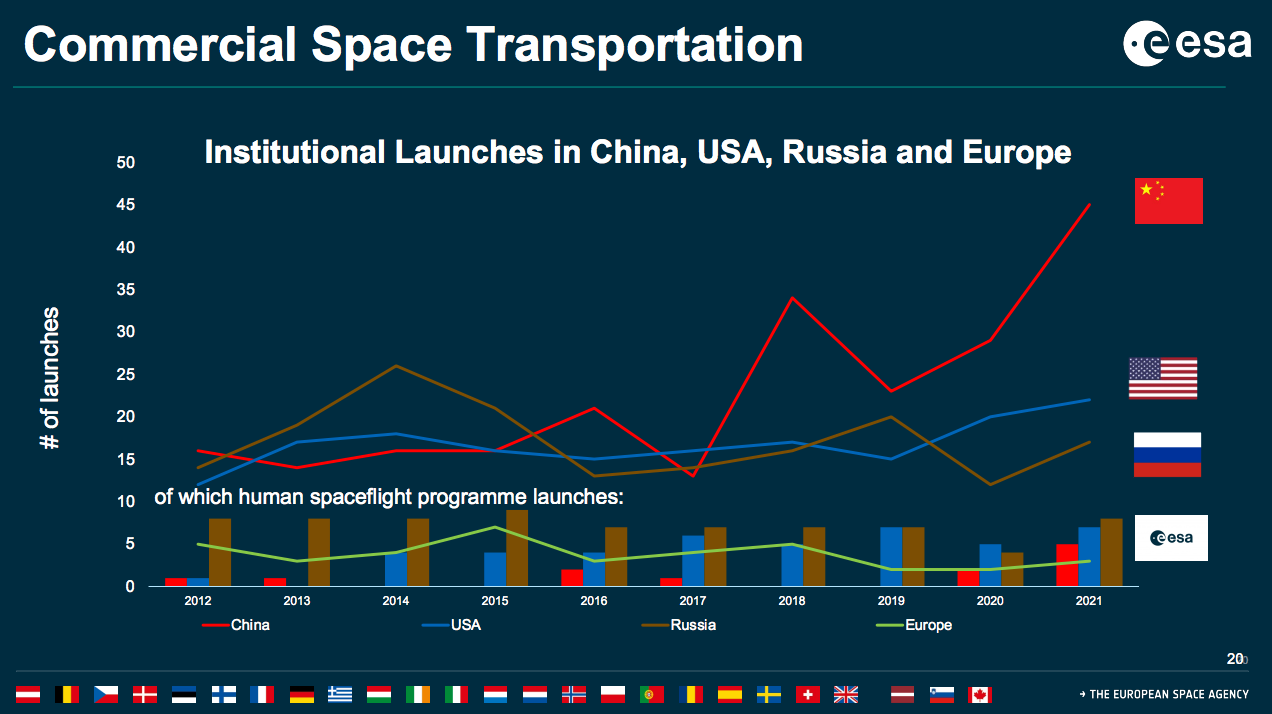Earth Observation, European Spacecraft & Astronaut Selection

A question of the budget
Director General Josef Aschbacher began the annual press conference by revealing the ESA budget for 2022, which shows a pleasing development - at 7,152 billion euros, the budget is almost 10% higher than last year's budget. 64.3% of the budget comes from the ESA member states. Aschbacher noted that the EU is also increasingly recognising the added value of ESA. They contributed 28.4% of the budget. However, the budget does not stand up to international comparison - NASA alone has a budget of almost 25 billion dollars in 2022.
According to Aschbacher, the lack of budget means that potentially great scientific, economic and also political benefits are not available in Europe, but would be enormously important for society. It is a political decision - and calls for talks to bring about a change.
Nevertheless, Europe has a model function in the field of Earth observation. Therefore, it is hardly surprising that a major share of the annual budget flows into precisely this area.
Goal: Co2 Neutral by 2050
A large part of ESA's research is on "Space for a Green Future", one of the three accelerators defined by the space agency. The goal is to support climate neutrality by 2050, partly with the help of a digital twin of the Earth.
"Digital Twin Earth" will help visualise, monitor and predict natural and human activities on the planet. The model will be able to monitor the health of the planet, perform simulations of the Earth system interconnected with human behaviour, and support the field of sustainable development, thus strengthening Europe's efforts for a better environment to respond to the urgent challenges and goals of the Green Deal. (Source: ESA)
Aschbacher emphasises that this digital twin allows the future of the Earth to be predicted - and positively influenced.
A plea for European spaceships
The head of the European Space Agency (ESA), Josef Aschbacher, pleads for the development of European space ships. The US, Russia, China and soon India all have their own spaceships, the Tyrolean geophysicist said in Tuesday's video press conference. "We don't have any and always have to fly along with others," he stressed.
He expressed confidence that appropriate political decisions would be taken at a European space meeting in Toulouse in February. The space nations have the opportunity to "explore the next frontiers and the next economic zone, i.e. the moon and beyond", Aschbacher said. He said it was astonishing that Europe, which had played a pioneering role in the 15th century, could not keep up today. "The explanation is quite simple: we don't have enough money," Aschbacher said.
The ESA's budget for space exploration last year was 735 million euros. That is about seven per cent of the amount NASA has at its disposal. The ESA, which comprises 22 member states, is planning a space summit for 16 February in Toulouse, following a meeting of the relevant EU ministers, at which French President Emmanuel Macron also plans to give a speech.

1400 Astronaut candidates in the next round
It is the first time in more than a decade that ESA is looking for new astronauts. Nearly 23,600 interested people applied - 1,391 have now been selected for the next round in the battle for a place in space, according to the European space agency. Among the more than 20,000 space aspirants were also 464 Austrians, 115 of them women. It is not yet known whether one or more Austrians made it into the deselection.
According to the ESA, the 1,391 candidates now have to pass cognitive, technical and motor coordination as well as personality tests. In a next step, psychological interviews, group tests and a medical examination will be conducted.
In total, ESA is looking for four to six astronauts who will be assigned to space missions as permanent ESA employees. In addition, the organisation is looking for up to 20 astronauts as a reserve. For this reserve pool, ESA is also explicitly looking for an astronaut with a certain degree of physical disability. The programme is called "Parastronaut". It is expected that ESA will announce who can look forward to an astronaut career in autumn 2022.
The yearly ESA Director General Press Conference
The video is provided via Youtube , a connection to the servers of Youtube is established (see privacy policy).
Further highlights in the space year 2022
Launch of the first MTG satellite in Q4 (with EUMETSAT)
The third generation of European weather satellites are significantly more powerful and provide more accurate data than their predecessors
Launch of the next Galileo satellites
Galileo Launch 12 with Galileo 29 and Galileo 30 is scheduled for March/April, Launch 13 with Galileo 31 and 32 between September and November. The satellites will begin their mission on board a Soyuz rocket.
JWST & GAIA data expected
The Webb Space Telescope will deliver its first data in the second or third quarter, GAIA will deliver its first groundbreaking data in the second quarter.
Ariane 6 and Vega C
Ariane 5 will make its first test flights in the second quarter, while Vega C will make its maiden flight in May.
Extension of the International Space Station
ESA expected to agree to participate in ISS extension to 2030
Rosalind Franklin on its way to Mars
The Rosalind Franklin Rover (formerly ExoMars) is expected to begin its journey to the red planet in September 2022.
ESA Ministerial Conference
The ESA Ministerial Conference will take place in Paris on 22-23 November.

